Table of Contents
Overview
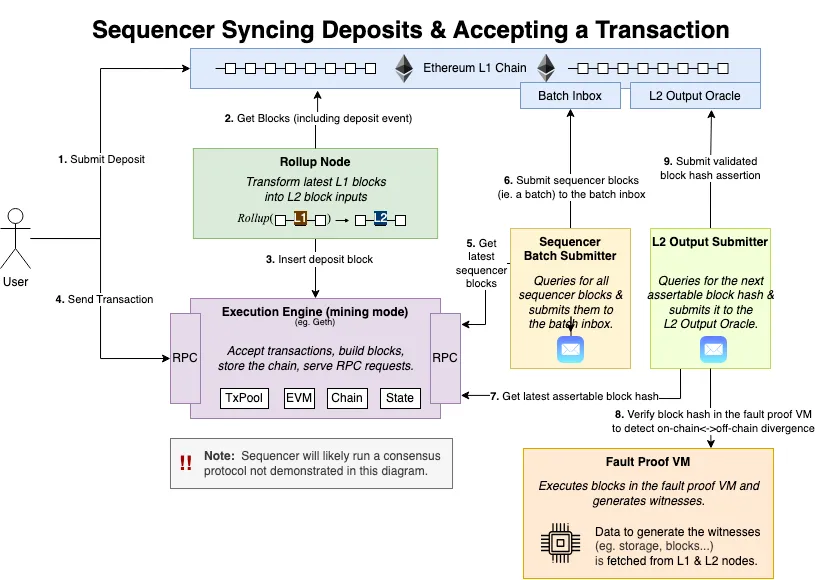
Components

L1 Components
- OptimismPortal: A feed of L2 transactions which originated as smart contract calls in the L1 state.
- The
OptimismPortalcontract emitsTransactionDepositedevents, which the rollup driver reads in order to process deposits. - Deposits are guaranteed to be reflected in the L2 state within the sequencing window.
- Beware that transactions are deposited, not tokens. However deposited transactions are a key part of implementing token deposits (tokens are locked on L1, then minted on L2 via a deposited transaction).
- The
- BatchInbox: An L1 address to which the Batch Submitter submits transaction batches.
- Transaction batches include L2 transaction calldata, timestamps, and ordering information.
- The BatchInbox is a regular EOA address. This lets us pass on gas cost savings by not executing any EVM code.
- L2OutputOracle: A smart contract that stores L2 output roots for use with withdrawals and fault proofs.
L2 Components
- Rollup Node:
- A standalone, stateless binary.
- Syncs and verifies rollup data on L1.
- Applies rollup-specific block production rules to synthesize blocks from L1.
- Appends blocks to the L2 chain using the Engine API.
- Handles L1 reorgs.
- Distributes unsubmitted blocks to other rollup nodes.
- Execution Engine (EE):
- A vanilla Geth node with minor modifications to support Optimism.
- Maintains L2 state.
- Sync state to other L2 nodes for fast onboarding.
- Serves the Engine API to the rollup node.
- Batch Submitter
- A background process that submits transaction batches to the
BatchInboxaddress.
- A background process that submits transaction batches to the
- Output Submitter
- A background process that submits L2 output commitments to the
L2OutputOracle.
- A background process that submits L2 output commitments to the
Transaction/Block Propagation
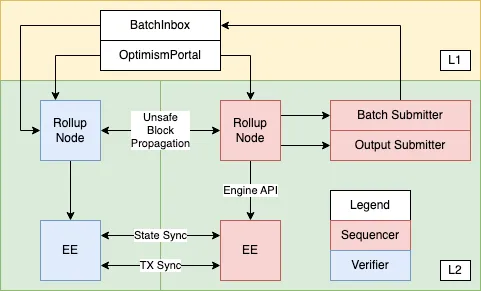
Block Derivation
The rollup chain can be deterministically derived given an L1 Ethereum chain. The fact that the entire rollup chain can be derived based on L1 blocks is what makes Optimism a rollup. This process can be represented as:
derive_rollup_chain(l1_blockchain) -> rollup_blockchain- unsafe transactions are already processed, but not written to L1 yet. A batcher fault might cause these transactions to be dropped.
- safe transactions are already processed and written to L1. However, they might be dropped due to a reorganization at the L1 level.
- finalized transactions are written to L1 in an L1 block that is old enough to be extremely unlikely to be re-organized.
For L1 block number n, there is a corresponding rollup epoch n which can only be derived after a sequencing window worth of blocks has passed, i.e. after L1 block number n + SEQUENCING_WINDOW_SIZE is added to the L1 chain.

Block Derivation Loop
A sub-component of the rollup node called the rollup driver is actually responsible for performing block derivation. The rollup driver is essentially an infinite loop that runs the block derivation function. For each epoch, the block derivation function performs the following steps:
- Downloads deposit and transaction batch data for each block in the sequencing window.
- Converts the deposit and transaction batch data into payload attributes for the Engine API.
- Submits the payload attributes to the Engine API, where they are converted into blocks and added to the canonical chain.
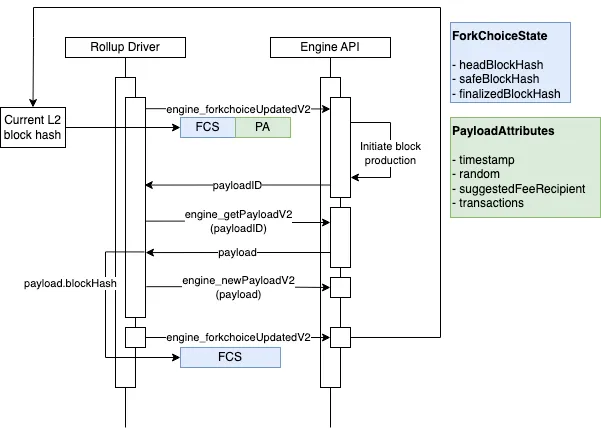
Bridges
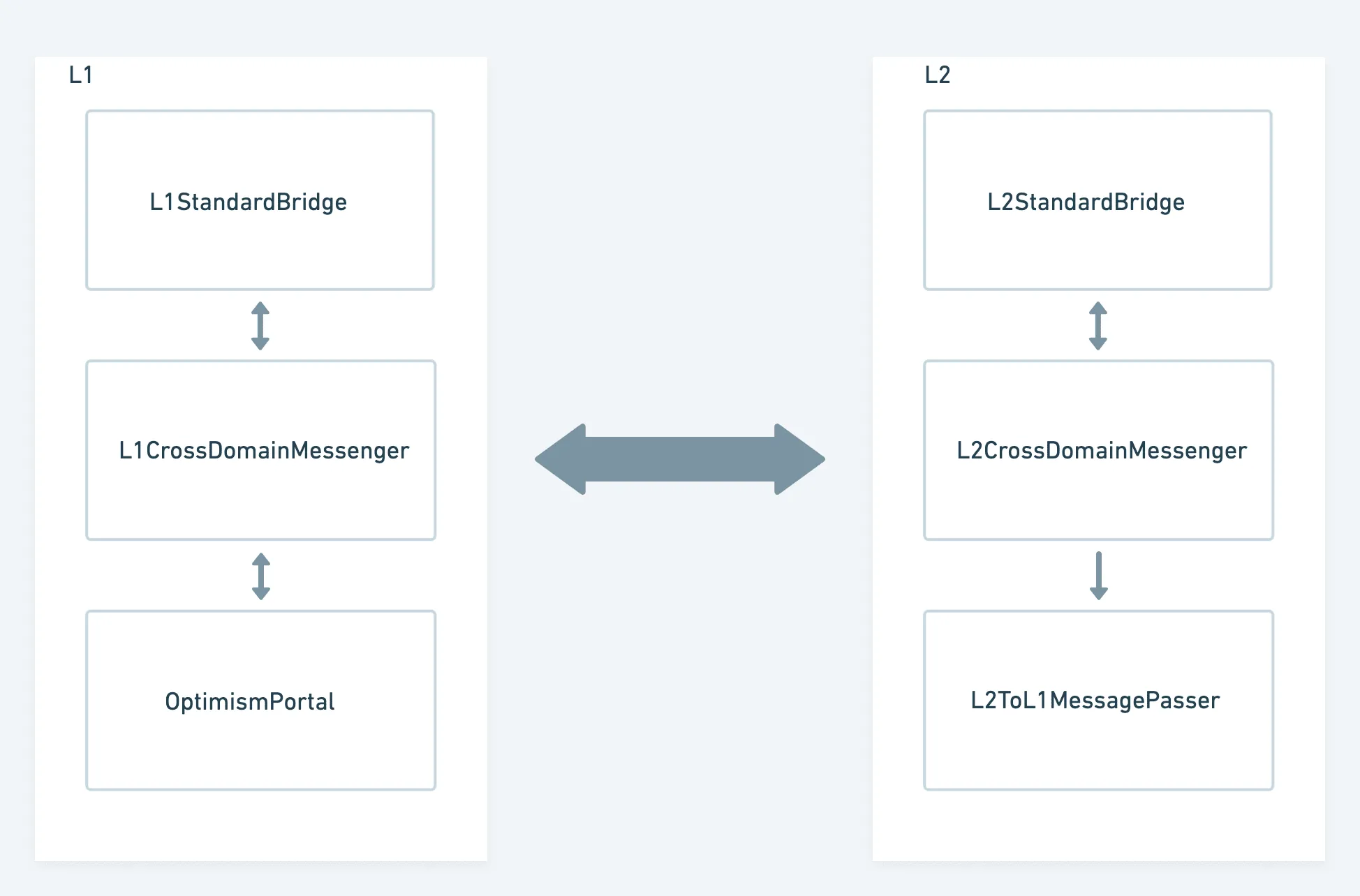
L1→L2
onL1
messenger.sendMessage{ value: _amount }({ _target: address(otherBridge), _message: abi.encodeWithSelector(this.finalizeBridgeETH.selector, _from, _to, _amount, _extraData), _minGasLimit: _minGasLimit });//L1CrossDomainMessenger.sol_sendMessage({ _to: address(otherMessenger), _gasLimit: baseGas(_message, _minGasLimit), _value: msg.value, _data: abi.encodeWithSelector( this.relayMessage.selector, messageNonce(), msg.sender, _target, msg.value, _minGasLimit, _message ) });function _sendMessage(address _to, uint64 _gasLimit, uint256 _value, bytes memory _data) internal override { portal.depositTransaction{ value: _value }({ _to: _to, _value: _value, _gasLimit: _gasLimit, _isCreation: false, _data: _data });}onL2
function relayMessage( uint256 _nonce, address _sender, address _target, uint256 _value, uint256 _minGasLimit, bytes calldata _message ){ if (_isOtherMessenger()) { assert(msg.value == _value); assert(!failedMessages[versionedHash]); } else { require(msg.value == 0, "CrossDomainMessenger: value must be zero unless message is from a system address"); require(failedMessages[versionedHash], "CrossDomainMessenger: message cannot be replayed"); } xDomainMsgSender = _sender; bool success = SafeCall.call(_target, gasleft() - RELAY_RESERVED_GAS, _value, _message); xDomainMsgSender = Constants.DEFAULT_L2_SENDER;}//L2StandardBridge.solmodifier onlyOtherBridge() { require( msg.sender == address(messenger) && messenger.xDomainMessageSender() == address(otherBridge), "StandardBridge: function can only be called from the other bridge" ); _;}function finalizeBridgeETH( address _from, address _to, uint256 _amount, bytes calldata _extraData) public payable onlyOtherBridge{ _emitETHBridgeFinalized(_from, _to, _amount, _extraData);
bool success = SafeCall.call(_to, gasleft(), _amount, hex""); require(success, "StandardBridge: ETH transfer failed");}L2→L1
function _sendMessage(address _to, uint64 _gasLimit, uint256 _value, bytes memory _data) internal override { L2ToL1MessagePasser(payable(Predeploys.L2_TO_L1_MESSAGE_PASSER)).initiateWithdrawal{ value: _value }( _to, _gasLimit, _data );}Deposit
The Deposited Transaction Type
Deposited transactions have the following notable distinctions from existing transaction types:
- They are derived from Layer 1 blocks, and must be included as part of the protocol.
- They do not include signature validation (see User-Deposited Transactions for the rationale).
- They buy their L2 gas on L1 and, as such, the L2 gas is not refundable.
Kinds of Deposited Transactions
- The first transaction MUST be a L1 attributes deposited transaction, followed by
- an array of zero-or-more user-deposited transactions submitted to the deposit feed contract on L1 (called
OptimismPortal). User-deposited transactions are only present in the first block of a L2 epoch.
An L1 attributes deposited transaction is a deposit transaction sent to the L1 attributes predeployed contract.
Withdraw
Withdrawals require the user to submit three transactions:
- Withdrawal initiating transaction, which the user submits on L2.
- Withdrawal proving transaction, which the user submits on L1 to prove that the withdrawal is legitimate (based on a merkle patricia trie root that commits to the state of the
L2ToL1MessagePasser’s storage on L2) - Withdrawal finalizing transaction, which the user submits on L1 after the fault challenge period has passed, to actually run the transaction on L1.
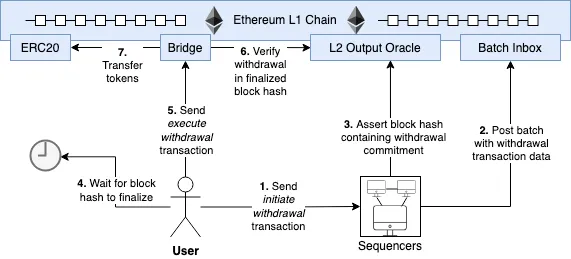
Withdrawal initiating transaction
calls initiateWithdrawal on L2ToL1MessagePasser. This function calculates the hash of the raw withdrawal fields. Mark sentMessages[withdrawalHash] = true
Withdrawal proving transaction
Once an output root that includes the MessagePassed event is published to L1, calls OptimismPortal.proveWithdrawalTransaction() on L1. To prove the given withdrawal in the L2ToL1MessagePasser contract.
function proveWithdrawalTransaction( Types.WithdrawalTransaction memory _tx, uint256 _l2OutputIndex, Types.OutputRootProof calldata _outputRootProof, bytes[] calldata _withdrawalProof) external;
function finalizeWithdrawalTransaction( Types.WithdrawalTransaction memory _tx) external;Withdrawal finalizing transaction
Once the fault challenge period passes, calls OptimismPortal.finalizeWithdrawalTransaction()on L1.Mark the withdrawal as finalized in finalizedWithdrawals.Run the actual withdrawal transaction.
OptimismPortal can send arbitrary messages on L1
The L2ToL1MessagePasser contract’s initiateWithdrawal function accepts a _target address and _data bytes, which is passed to a CALL opcode on L1 when finalizeWithdrawalTransaction is called after the challenge period. This means that, by design, the OptimismPortal contract can be used to send arbitrary transactions on the L1, with the OptimismPortal as the msg.sender.
This means users of the OptimismPortal contract should be careful what permissions they grant to the portal. For example, any ERC20 tokens mistakenly sent to the OptimismPortal contract are essentially lost, as they can be claimed by anybody that pre-approves transfers of this token out of the portal, using the L2 to initiate the approval and the L1 to prove and finalize the approval (after the challenge period).
op-node
Derivation
To derive the L2 blocks of epoch number E, we need the following inputs:
- L1 blocks in the range
[E, E + SWS), called the sequencing window of the epoch, andSWSthe sequencing window size. (Note that sequencing windows overlap.) - Batcher transactions from blocks in the sequencing window.
- These transactions allow us to reconstruct the epoch’s sequencer batches, each of which will produce one L2 block. Note that:
- The L1 origin will never contain any data needed to construct sequencer batches since each batch must contain the L1 origin hash.
- An epoch may have no sequencer batches.
- These transactions allow us to reconstruct the epoch’s sequencer batches, each of which will produce one L2 block. Note that:
- Deposits made in the L1 origin (in the form of events emitted by the deposit contract).
- L1 block attributes from the L1 origin (to derive the L1 attributes deposited transaction).
- The state of the L2 chain after the last L2 block of the previous epoch, or the L2 genesis state if
Eis the first epoch.
Each L2 block with origin l1_origin is subject to the following constraints (whose values are denominated in seconds):
block.timestamp = prev_l2_timestamp + l2_block_timeprev_l2_timestampis the timestamp of the L2 block immediately preceding this one. If there is no preceding block, then this is the genesis block, and its timestamp is explicitly specified.l2_block_timeis a configurable parameter of the time between L2 blocks (2s on Optimism).
l1_origin.timestamp <= block.timestamp <= max_l2_timestamp, wheremax_l2_timestamp = max(l1_origin.timestamp + max_sequencer_drift, prev_l2_timestamp + l2_block_time)max_sequencer_driftis a configurable parameter that bounds how far the sequencer can get ahead of the L1.
Finally, each epoch must have at least one L2 block.
Batch Submission Wire Format
L2 Chain Derivation Pipeline
The derivation process into a pipeline made up of the following stages:
- L1 Traversal
- L1 Retrieval
- Frame Queue
- Channel Bank
- Channel Reader (Batch Decoding)
- Batch Queue
- Payload Attributes Derivation
- Engine Queue
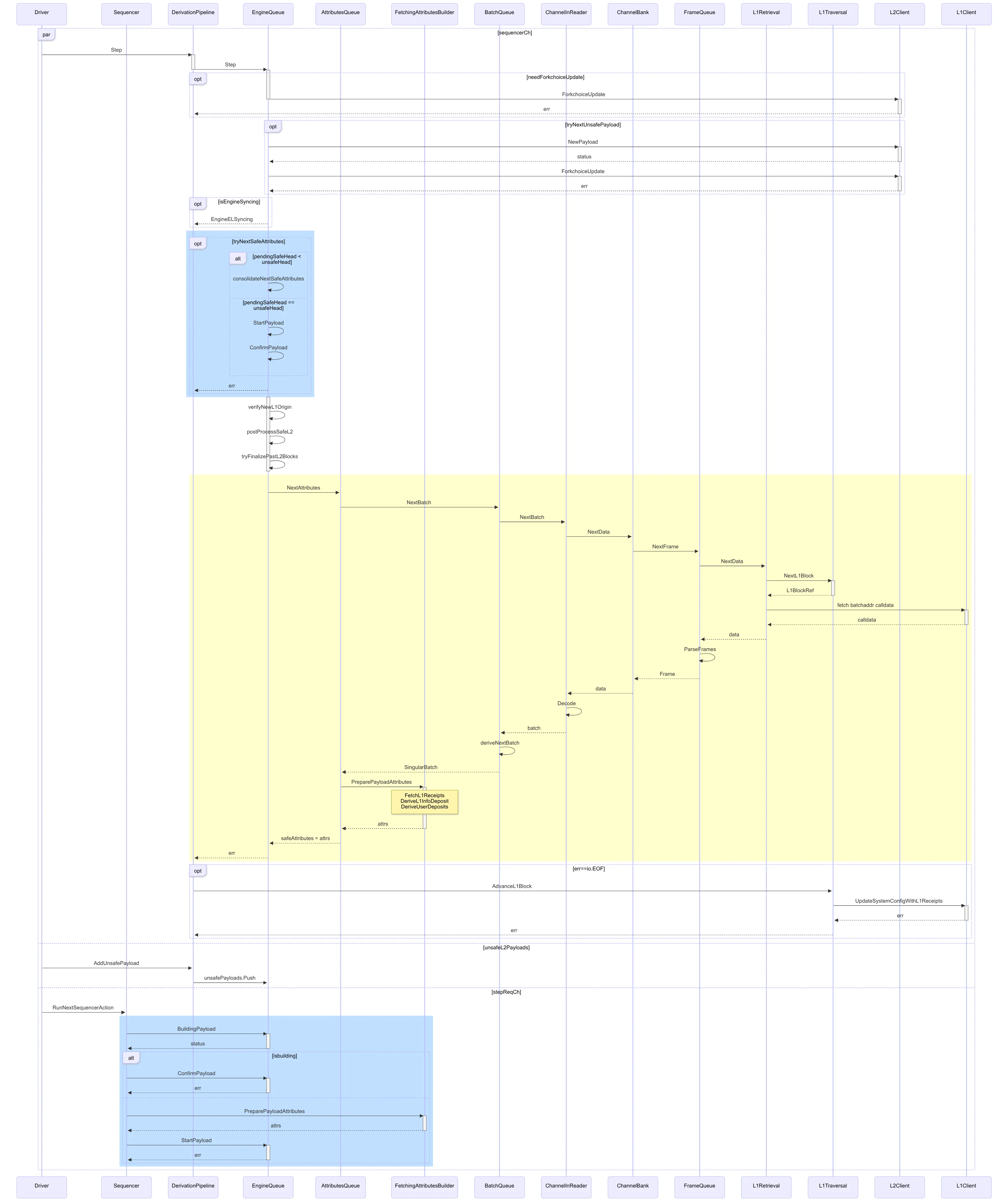
mermaid
sequenceDiagram participant Driver participant Sequencer participant DerivationPipeline participant EngineQueue participant AttributesQueue participant FetchingAttributesBuilder participant BatchQueue participant ChannelInReader participant ChannelBank participant FrameQueue participant L1Retrieval participant L1Traversal participant L2Client participant L1Client
par sequencerCh Driver->>DerivationPipeline: Step activate DerivationPipeline DerivationPipeline->>EngineQueue: Step deactivate DerivationPipeline activate EngineQueue opt needForkchoiceUpdate EngineQueue->>L2Client: ForkchoiceUpdate deactivate EngineQueue activate L2Client L2Client-->>DerivationPipeline: err deactivate L2Client end
opt tryNextUnsafePayload EngineQueue->>L2Client: NewPayload activate L2Client L2Client-->>EngineQueue: status deactivate L2Client EngineQueue->>L2Client: ForkchoiceUpdate activate L2Client L2Client-->>EngineQueue: err deactivate L2Client end opt isEngineSyncing EngineQueue-->>DerivationPipeline: EngineELSyncing end rect rgb(191, 223, 255) opt tryNextSafeAttributes alt pendingSafeHead < unsafeHead EngineQueue->>EngineQueue: consolidateNextSafeAttributes else pendingSafeHead == unsafeHead EngineQueue->>EngineQueue: StartPayload EngineQueue->>EngineQueue: ConfirmPayload end EngineQueue-->>DerivationPipeline: err end end activate EngineQueue EngineQueue->>EngineQueue: verifyNewL1Origin EngineQueue->>EngineQueue: postProcessSafeL2 EngineQueue->>EngineQueue: tryFinalizePastL2Blocks deactivate EngineQueue
rect rgb(255, 255, 204) EngineQueue->>AttributesQueue: NextAttributes AttributesQueue->>BatchQueue: NextBatch BatchQueue->>ChannelInReader: NextBatch ChannelInReader->>ChannelBank: NextData ChannelBank->>FrameQueue: NextFrame FrameQueue->>L1Retrieval: NextData L1Retrieval->>L1Traversal: NextL1Block activate L1Traversal
L1Traversal-->>L1Retrieval: L1BlockRef deactivate L1Traversal L1Retrieval->>L1Client: fetch batchaddr calldata activate L1Client L1Client-->>L1Retrieval: calldata deactivate L1Client L1Retrieval-->>FrameQueue: data FrameQueue->>FrameQueue: ParseFrames FrameQueue-->>ChannelBank: Frame ChannelBank-->>ChannelInReader: data ChannelInReader->>ChannelInReader: Decode ChannelInReader-->>BatchQueue: batch BatchQueue->>BatchQueue: deriveNextBatch BatchQueue-->>AttributesQueue: SingularBatch
AttributesQueue->>FetchingAttributesBuilder: PreparePayloadAttributes activate FetchingAttributesBuilder Note over FetchingAttributesBuilder: FetchL1Receipts<br/>DeriveL1InfoDeposit<br/>DeriveUserDeposits FetchingAttributesBuilder-->>AttributesQueue: attrs deactivate FetchingAttributesBuilder AttributesQueue-->>EngineQueue: safeAttributes = attrs
EngineQueue-->>DerivationPipeline: err end opt err==io.EOF DerivationPipeline->>L1Traversal: AdvanceL1Block L1Traversal->>L1Client: UpdateSystemConfigWithL1Receipts activate L1Client L1Client-->>L1Traversal: err deactivate L1Client L1Traversal-->>DerivationPipeline: err end
and unsafeL2Payloads Driver->>DerivationPipeline: AddUnsafePayload DerivationPipeline->>EngineQueue: unsafePayloads.Push and stepReqCh Driver->>Sequencer: RunNextSequencerAction rect rgb(191, 223, 255) Sequencer->>EngineQueue: BuildingPayload activate EngineQueue EngineQueue-->>Sequencer: status deactivate EngineQueue alt isbuilding Sequencer->>EngineQueue: ConfirmPayload activate EngineQueue EngineQueue-->>Sequencer: err deactivate EngineQueue else Sequencer->>FetchingAttributesBuilder: PreparePayloadAttributes activate FetchingAttributesBuilder FetchingAttributesBuilder-->>Sequencer: attrs deactivate FetchingAttributesBuilder Sequencer->>EngineQueue: StartPayload activate EngineQueue EngineQueue-->>Sequencer: err deactivate EngineQueue end end endop-batcher
The most minimal batcher implementation can be defined as a loop of the following operations:
- See if the
unsafeL2 block number is past thesafeblock number:unsafedata needs to be submitted. - Iterate over all unsafe L2 blocks, skip any that were previously submitted.
- Open a channel, buffer all the L2 block data to be submitted, while applying the encoding and compression as defined in the derivation spec.
- Pull frames from the channel to fill data transactions with, until the channel is empty.
- Submit the data transactions to L1
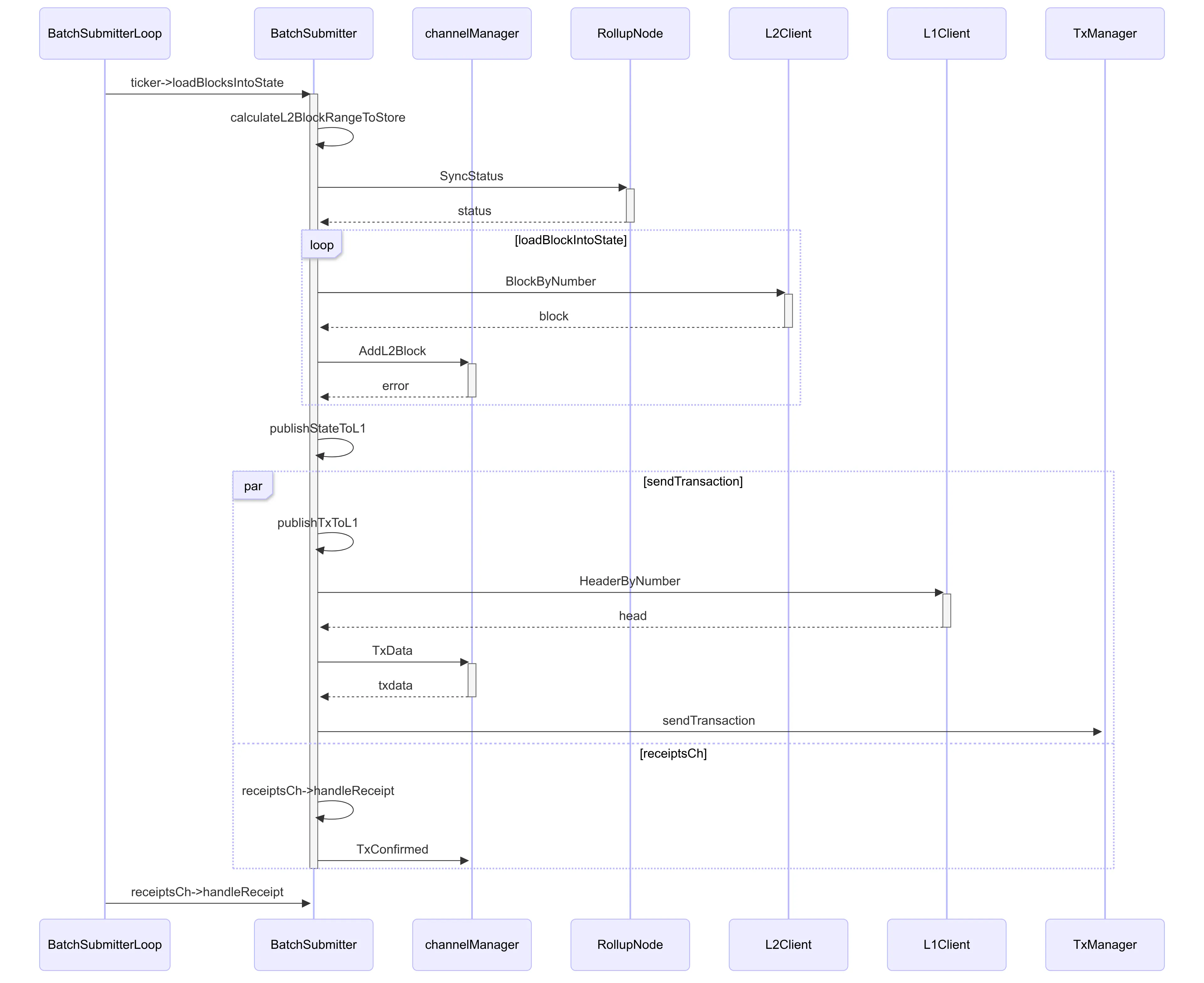
mermaid
sequenceDiagram participant BatchSubmitterLoop participant BatchSubmitter participant channelManager participant RollupNode participant L2Client participant L1Client participant TxManager
BatchSubmitterLoop->>BatchSubmitter: ticker->loadBlocksIntoState activate BatchSubmitter BatchSubmitter->>BatchSubmitter: calculateL2BlockRangeToStore
BatchSubmitter->>RollupNode: SyncStatus activate RollupNode RollupNode-->>BatchSubmitter: status deactivate RollupNode
loop loadBlockIntoState BatchSubmitter->>L2Client: BlockByNumber activate L2Client L2Client-->>BatchSubmitter: block deactivate L2Client
BatchSubmitter->>channelManager: AddL2Block activate channelManager channelManager-->>BatchSubmitter: error deactivate channelManager end
BatchSubmitter->>BatchSubmitter: publishStateToL1
par sendTransaction BatchSubmitter->>BatchSubmitter: publishTxToL1 BatchSubmitter->>L1Client: HeaderByNumber activate L1Client L1Client-->>BatchSubmitter: head deactivate L1Client
BatchSubmitter->>channelManager: TxData activate channelManager channelManager-->>BatchSubmitter: txdata deactivate channelManager
BatchSubmitter->>TxManager: sendTransaction and receiptsCh BatchSubmitter->>BatchSubmitter: receiptsCh->handleReceipt BatchSubmitter->>channelManager: TxConfirmed end deactivate BatchSubmitter BatchSubmitterLoop->>BatchSubmitter: receiptsCh->handleReceiptop-proposer
The output_root is a 32 byte string, which is derived based on the a versioned scheme:
output_root = keccak256(version_byte || payload)payload = state_root || withdrawal_storage_root || latest_block_hash
function proposeL2Output( bytes32 _l2Output, uint256 _l2BlockNumber, bytes32 _l1Blockhash, uint256 _l1BlockNumber)where:
- The
latest_block_hash(bytes32) is the block hash for the latest L2 block. - The
state_root(bytes32) is the Merkle-Patricia-Trie (MPT) root of all execution-layer accounts. This value is frequently used and thus elevated closer to the L2 output root, which removes the need to prove its inclusion in the pre-image of thelatest_block_hash. This reduces the merkle proof depth and cost of accessing the L2 state root on L1. - The
withdrawal_storage_root(bytes32) elevates the Merkle-Patricia-Trie (MPT) root of the Message Passer contract storage. Instead of making an MPT proof for a withdrawal against the state root (proving first the storage root of the L2toL1MessagePasser against the state root, then the withdrawal against that storage root), we can prove against the L2toL1MessagePasser’s storage root directly, thus reducing the verification cost of withdrawals on L1.
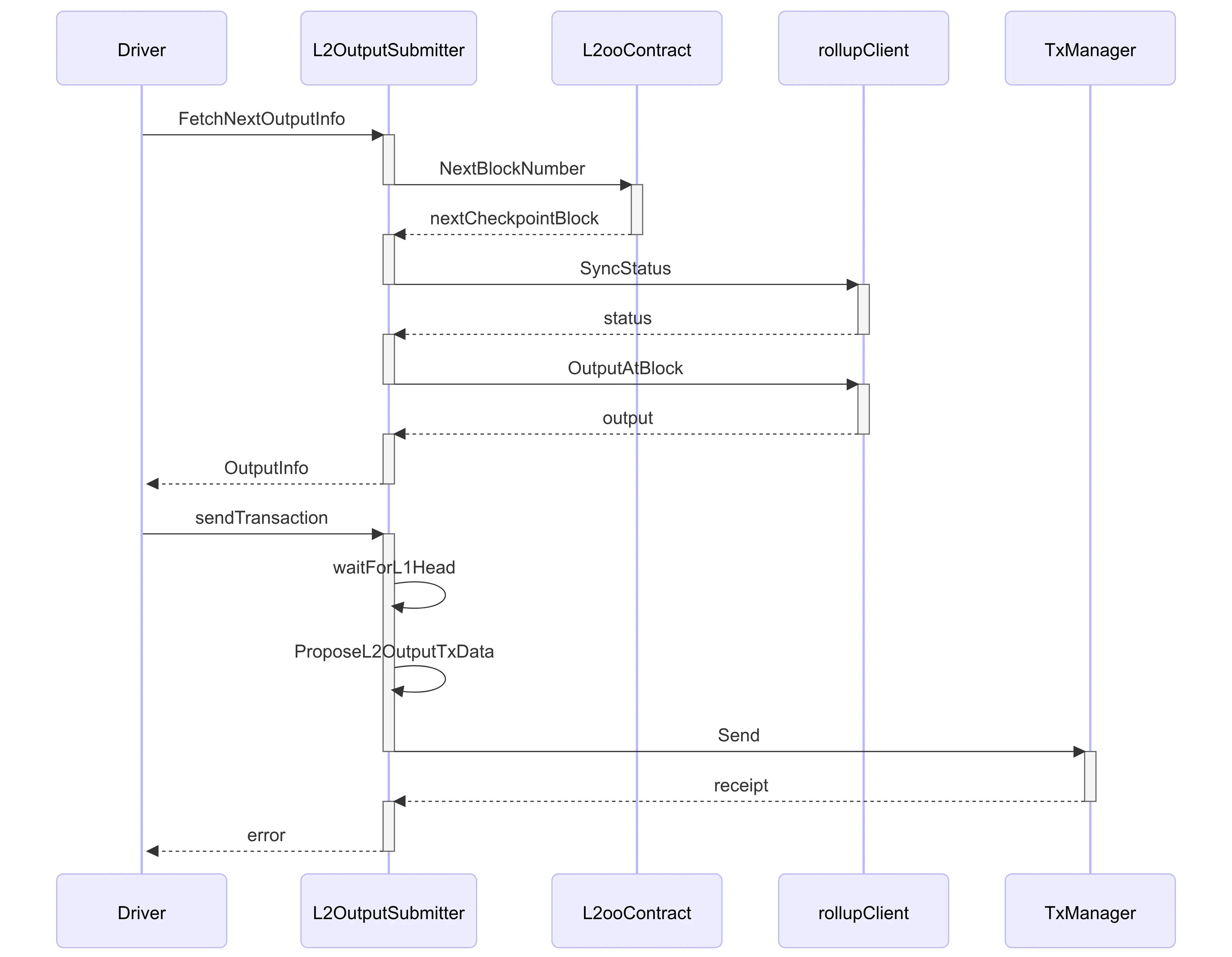
mermaid
sequenceDiagram participant Driver participant L2OutputSubmitter participant L2ooContract participant rollupClient participant TxManager
Driver->>L2OutputSubmitter: FetchNextOutputInfo activate L2OutputSubmitter L2OutputSubmitter->>L2ooContract: NextBlockNumber deactivate L2OutputSubmitter activate L2ooContract L2ooContract-->>L2OutputSubmitter: nextCheckpointBlock deactivate L2ooContract
activate L2OutputSubmitter L2OutputSubmitter->>rollupClient: SyncStatus deactivate L2OutputSubmitter activate rollupClient rollupClient-->>L2OutputSubmitter: status deactivate rollupClient
activate L2OutputSubmitter L2OutputSubmitter->>rollupClient: OutputAtBlock deactivate L2OutputSubmitter activate rollupClient rollupClient-->>L2OutputSubmitter: output deactivate rollupClient
activate L2OutputSubmitter L2OutputSubmitter-->>Driver: OutputInfo deactivate L2OutputSubmitter
Driver->>L2OutputSubmitter: sendTransaction activate L2OutputSubmitter
L2OutputSubmitter->>L2OutputSubmitter: waitForL1Head L2OutputSubmitter->>L2OutputSubmitter: ProposeL2OutputTxData
L2OutputSubmitter->>TxManager: Send deactivate L2OutputSubmitter
activate TxManager TxManager-->>L2OutputSubmitter: receipt deactivate TxManager
activate L2OutputSubmitter L2OutputSubmitter-->>Driver: error deactivate L2OutputSubmitterL1 Reorgs
If the L1 has a reorg after an output has been generated and submitted, the L2 state and correct output may change leading to a faulty proposal. This is mitigated against by allowing the proposer to submit an L1 block number and hash to the Output Oracle when appending a new output; in the event of a reorg, the block hash will not match that of the block with that number and the call will revert.
if (_l1BlockHash != bytes32(0)) { // This check allows the proposer to propose an output based on a given L1 block, // without fear that it will be reorged out. // It will also revert if the blockheight provided is more than 256 blocks behind the // chain tip (as the hash will return as zero). This does open the door to a griefing // attack in which the proposer's submission is censored until the block is no longer // retrievable, if the proposer is experiencing this attack it can simply leave out the // blockhash value, and delay submission until it is confident that the L1 block is // finalized. require( blockhash(_l1BlockNumber) == _l1BlockHash, "L2OutputOracle: block hash does not match the hash at the expected height" ); }Fault proof
A fault proof, also known as fraud proof or interactive game, consists of 3 components:
- Program: Fault Proof Program(FPP), given a commitment to all rollup inputs (L1 data) and the dispute, verify the dispute statelessly.
- VM: Fault Proof Virtual Machine(FPVM), given a stateless program and its inputs, trace any instruction step, and prove it on L1.
- Interactive Dispute Game:Fault Dispute Game(FDG), bisect a dispute down to a single instruction, and resolve the base-case using the VM.
Process
- Compile the core derivation function (op-program) to MIPS(Fault Proof Program)
- Generate the instruction trace (Fault Proof VM)
- Bisect the instruction trace to find a disagreement on the specific instruction (Dispute Game)
- Execute the single instruction on-chain to validate the claimed post-state (Cannon)
- Keep or remove proposed output depending on the result of the game
op-program
The Fault Proof Program defines the verification of claims of the state-transition outputs of the L2 rollup as a pure function of L1 data.
op-program-host: env GO111MODULE=on GOOS=$(TARGETOS) GOARCH=$(TARGETARCH) go build -v $(LDFLAGS) -o ./bin/op-program ./host/cmd/main.goop-program-client: env GO111MODULE=on GOOS=$(TARGETOS) GOARCH=$(TARGETARCH) go build -v $(LDFLAGS) -o ./bin/op-program-client ./client/cmd/main.goop-program-client-mips: env GO111MODULE=on GOOS=linux GOARCH=mips GOMIPS=softfloat go build -v $(LDFLAGS) -o ./bin/op-program-client.elf ./client/cmd/main.go./bin/op-program \--l1.trustrpc \--l1.rpckind alchemy \--l1 https://eth-sepolia.g.alchemy.com/v2/ \--l2 http://127.0.0.1:8545 \--l1.head 0x33dc65e2e8a49255d919d012943776b0431ccddb44c5dbb2f341701627fe9b29 \--l2.head 0xf8920b9f5f837019a410bf67a3047fd1831e3aeb56c76df072e77fe4e82fbac3 \--l2.outputroot AA7DDB0142CEE1DC77D31A8F27372ABBF136D65EA04177388044D7918E7A6588 \--l2.claim 0x530658ab1b1b3ff4829731fc8d5955f0e6b8410db2cd65b572067ba58df1f2b9 \--l2.blocknumber 245 \--datadir /tmp/fpp-database \--rollup.config ../op-node/rollup.json \--l2.genesis ../op-node/genesis.jsonPre-image Oracle
The pre-image oracle is the only form of communication between the Program (in the Client role) and the VM (in the Server role).
The program uses the pre-image oracle to query any input data that is understood to be available to the user:
- The initial inputs to bootstrap the program. See Bootstrapping.
- External data not already part of the program code. See Pre-image hinting routes.
The communication happens over a simple request-response wire protocol, see Pre-image communication.
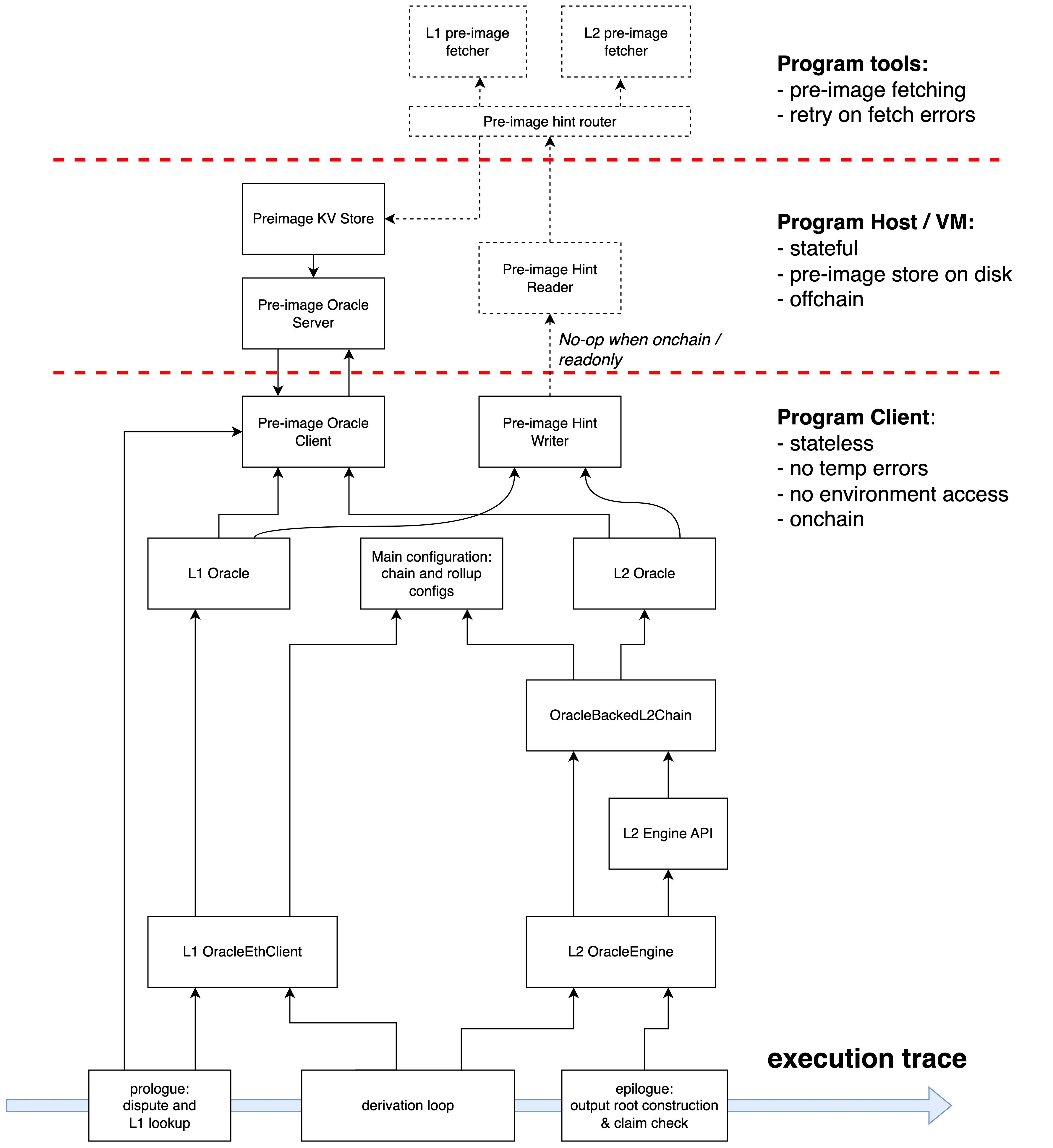
cannon
- a smart-contract to verify a single execution-trace step, e.g. a single MIPS instruction.
- a CLI command to generate a proof of a single execution-trace step.
- a CLI command to compute a VM state-root at step N
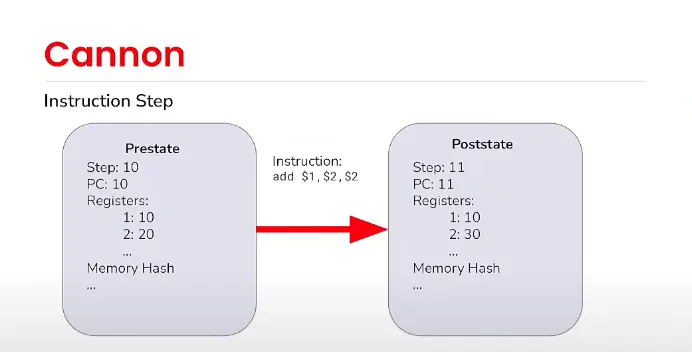
Operationally, the FPVM is a state transition function. This state transition is referred to as a
Step, that executes a single instruction. We say the VM is a function , given an input state
, steps on a single instruction encoded in the state to produce a new state.
There are 3 types of witness data involved in onchain execution:
The memory access is specifically:
- instruction (4 byte) read at
PC - load or syscall mem read, always aligned 4 bytes, read at any
addr - store or syscall mem write, always aligned 4 bytes, at the same
addr
Implementation
onchain step verify
- It’s Solidity code
- …emulating a MIPS machine
- …running compiled Go code
- …that runs an EVM
offchain generate proof
- It’s Go code
- …emulating a MIPS machine
- …running compiled Go code
- …that runs an EVM
offchain step verify
(for test)
- It’s Go code
- …that runs an EVM(use MIPS.sol)
- …emulating a MIPS machine
- …running compiled Go code
- …that runs an EVM
State
The virtual machine state highlights the effects of running a Fault Proof Program on the VM. It consists of the following fields:
memRoot- Abytes32value representing the merkle root of VM memory.preimageKey-bytes32value of the last requested pre-image key.preimageOffset- The 32-bit value of the last requested pre-image offset.pc- 32-bit program counter.nextPC- 32-bit next program counter. Note that this value may not always be when executing a branch/jump delay slot.lo- 32-bit MIPS LO special register.hi- 32-bit MIPS HI special register.heap- 32-bit base address of the most recent memory allocation via mmap.exitCode- 8-bit exit code.exited- 1-bit indicator that the VM has exited.registers- General-purpose MIPS32 registers. Each register is a 32-bit value.
The state is represented by packing the above fields, in order, into a 226-byte buffer.
State Hash
The state hash is computed by hashing the 226-byte state buffer with the Keccak256 hash function and then setting the high-order byte to the respective VM status.
// @param _stateData The encoded state witness data.// @param _proof The encoded proof data for leaves within the MIPS VM's memory.// @param _localContext The local key context for the preimage oracle. Optional, can be set as a constant if the caller only requires one set of local keys.function step(bytes calldata _stateData, bytes calldata _proof, bytes32 _localContext) public returns (bytes32)//The proof of a single execution-trace step:MerkleProof of state.PC and read/write memory addrtype Proof struct { Step uint64 `json:"step"` Pre common.Hash `json:"pre"` Post common.Hash `json:"post"` StateData hexutil.Bytes `json:"state-data"` ProofData hexutil.Bytes `json:"proof-data"` OracleKey hexutil.Bytes `json:"oracle-key,omitempty"` OracleValue hexutil.Bytes `json:"oracle-value,omitempty"` OracleOffset uint32 `json:"oracle-offset,omitempty"`}Memory
4-byte aligned
AddrSize:32bit
PageSize:4KB (12bit)
PageNumberSize:20bit
Merkleize:A binary merkle tree, has a fixed-depth of 27 levels, with leaf values of 32 bytes each. This spans the full 32-bit address space:
proof:[28 * 32]byte, the first two are leaf node, others areKeccak256Hash
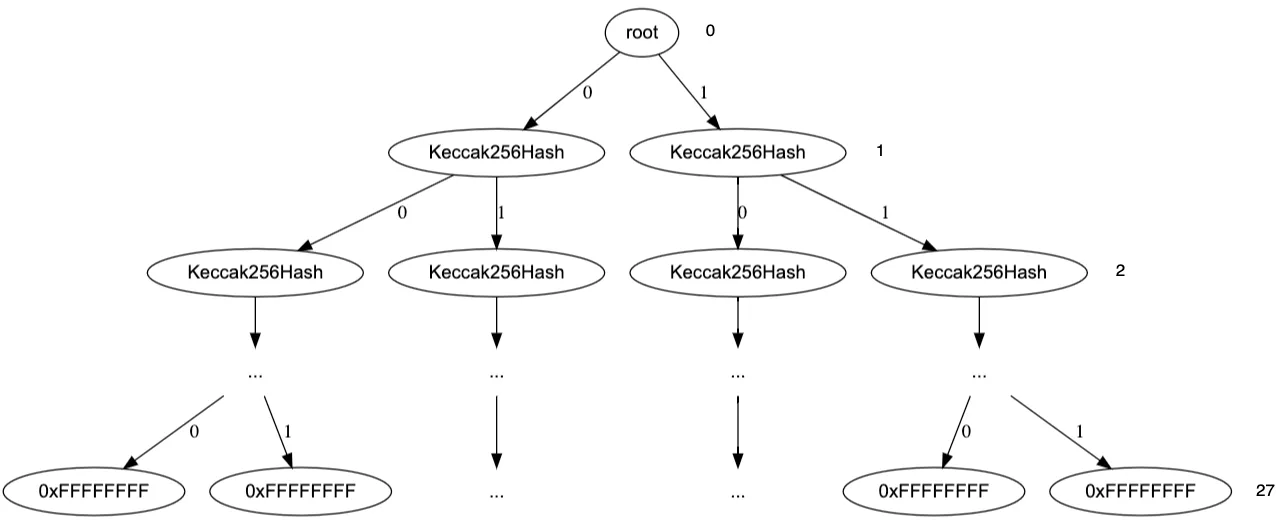
type Memory struct { // generalized index -> merkle root or nil if invalidated nodes map[uint64]*[32]byte // pageIndex -> cached page pages map[uint32]*CachedPage // Note: since we don't de-alloc pages, we don't do ref-counting. // Once a page exists, it doesn't leave memory // two caches: we often read instructions from one page, and do memory things with another page. // this prevents map lookups each instruction lastPageKeys [2]uint32 lastPage [2]*CachedPage}Syscalls
Syscalls work similar to Linux/MIPS, including the syscall calling conventions and general syscall handling behavior. However, the FPVM supports a subset of Linux/MIPS syscalls with slightly different behaviors. The following table list summarizes the supported syscalls and their behaviors.
| $v0 | system call | $a0 | $a1 | $a2 | Effect |
|---|---|---|---|---|---|
| 4090 | mmap | uint32 addr | uint32 len | Allocates a page from the heap. See heap for details. | |
| 4045 | brk | Returns a fixed address for the program break at 0x40000000 | |||
| 4120 | clone | Returns 1 | |||
| 4246 | exit_group | uint8 exit_code | Sets the Exited and ExitCode states to true and $a0 respectively. | ||
| 4003 | read | uint32 fd | char *buf | uint32 count | Similar behavior as Linux/MIPS with support for unaligned reads. See I/O for more details. |
| 4004 | write | uint32 fd | char *buf | uint32 count | Similar behavior as Linux/MIPS with support for unaligned writes. See I/O for more details. |
| 4055 | fcntl | uint32 fd | int32 cmd | Similar behavior as Linux/MIPS. Only the F_GETFL (3) cmd is supported. Sets errno to 0x16 for all other commands |
I/O
Map the fd returned by the parent process pipe to the pre-set fd of the child process:
// in cannon// call os.Pipe()cmd.ExtraFiles = []*os.File{ hOracleRW.Reader(), hOracleRW.Writer(), pOracleRW.Reader(), pOracleRW.Writer(), }// in op-program-hostfunc CreatePreimageChannel() oppio.FileChannel { r := os.NewFile(PClientRFd, "preimage-oracle-read") w := os.NewFile(PClientWFd, "preimage-oracle-write") return oppio.NewReadWritePair(r, w)}The VM does not support Linux open(2). However, the VM can read from and write to a predefined set of file descriptors.
| Name | File descriptor | Description |
|---|---|---|
| stdin | 0 | read-only standard input stream. |
| stdout | 1 | write-only standard output stream. |
| stderr | 2 | write-only standard error stream. |
| hint response | 3 | read-only. Used to read the status of pre-image hinting. |
| hint request | 4 | write-only. Used to provide pre-image hints |
| pre-image response | 5 | read-only. Used to read pre-images. |
| pre-image request | 6 | write-only. Used to request pre-images. |
PreimageOracle
Local key
This type of key is used for program bootstrapping, to identify the initial input arguments by index or name.****
| Identifier | Description |
|---|---|
0 | Parent L1 head hash at the time of the proposal |
1 | Starting output root hash (commits to block # n) |
2 | Disputed output root hash (commits to block # n + 1) |
3 | Starting L2 block number (block # n) |
4 | Chain ID |
Global keccak256 key
This type of key uses a global pre-image store contract, and is fully context-independent and permissionless.For global keccak256 preimages, there are two routes for players to submit:
- Small preimages atomically.
- Large preimages via streaming.
func (d *StateMatrix) StateCommitment() common.Hash { buf := d.PackState() return crypto.Keccak256Hash(buf)}func (d *StateMatrix) PackState() []byte { buf := make([]byte, 0, len(d.s.a)*uint256Size) for _, v := range d.s.a { buf = append(buf, math.U256Bytes(new(big.Int).SetUint64(v))...) } return buf}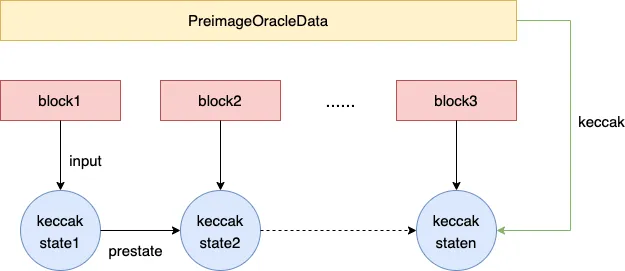
Once the full preimage and all intermediate state commitments have been posted, the large preimage proposal enters a challenge period. During this time, a challenger can reconstruct the merkle tree that was progressively built on-chain locally by scanning the block bodies that contain the proposer’s leaf preimages. If they detect that a commitment to the intermediate state of the hash function is incorrect at any step, they may perform a single-step dispute for the proposal in the PreimageOracle .
The depth of the keccak256 merkle tree is 16. Supports up to 65,536 keccak blocks, or ~8.91MB preimages.
function _hashLeaf(Leaf memory _leaf) internal pure returns (bytes32 leaf_) { leaf_ = keccak256(abi.encodePacked(_leaf.input, _leaf.index, _leaf.stateCommitment)); }merkleize onchain
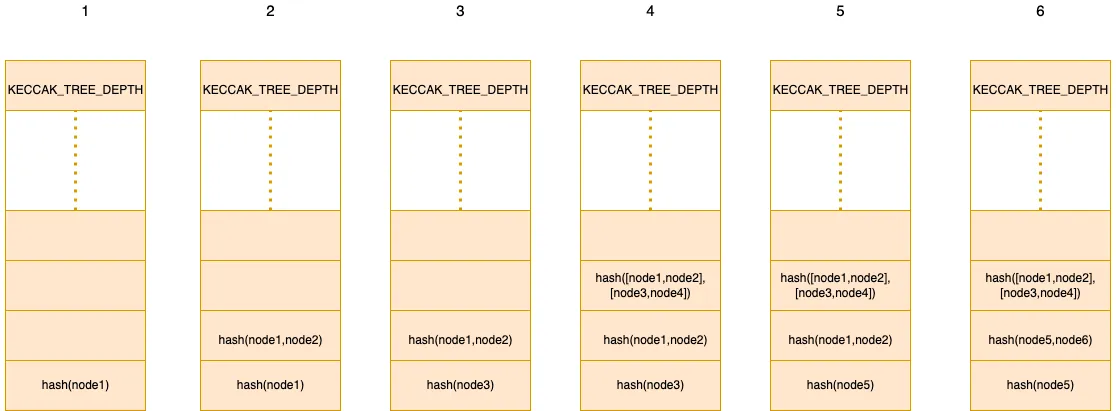
/// @notice Mapping of claimants to proposal UUIDs to the current branch path of the merkleization process.mapping(address => mapping(uint256 => bytes32[KECCAK_TREE_DEPTH])) public proposalBranches;
for { let i := 0 } lt(i, inputLen) { i := add(i, 136) } { // Copy the leaf preimage into the hashing buffer. // ... // Hash the leaf preimage to get the node to add. let node := keccak256(hashBuf, 0xC8)
// Increment the number of blocks processed. blocksProcessed := add(blocksProcessed, 0x01)
// Add the node to the tree. let size := blocksProcessed for { let height := 0x00 } lt(height, shl(0x05, KECCAK_TREE_DEPTH)) { height := add(height, 0x20) } { if and(size, 0x01) { mstore(add(branch, height), node) break }
// Hash the node at `height` in the branch and the node together. mstore(0x00, mload(add(branch, height))) mstore(0x20, node) node := keccak256(0x00, 0x40) size := shr(0x01, size) }}function getTreeRootLPP(address _owner, uint256 _uuid) public view returns (bytes32 treeRoot_) { uint256 size = proposalMetadata[_owner][_uuid].blocksProcessed(); for (uint256 height = 0; height < KECCAK_TREE_DEPTH; height++) { if ((size & 1) == 1) { treeRoot_ = keccak256(abi.encode(proposalBranches[_owner][_uuid][height], treeRoot_)); } else { treeRoot_ = keccak256(abi.encode(treeRoot_, zeroHashes[height])); } size >>= 1; } }function challengeFirstLPP( address _claimant, uint256 _uuid, Leaf calldata _postState, bytes32[] calldata _postStateProof ) external { bytes32 root = getTreeRootLPP(_claimant, _uuid); if (!_verify(_postStateProof, root, _postState.index, _hashLeaf(_postState))) revert InvalidProof();
if (_postState.index != 0) revert StatesNotContiguous(); LibKeccak.StateMatrix memory stateMatrix; LibKeccak.absorb(stateMatrix, _postState.input); LibKeccak.permutation(stateMatrix);
if (keccak256(abi.encode(stateMatrix)) == _postState.stateCommitment) revert PostStateMatches();
proposalMetadata[_claimant][_uuid] = proposalMetadata[_claimant][_uuid].setCountered(true); }op-challenger
The honest challenger is an agent interacting in the Fault Dispute Game (FDG) that supports honest claims and disputes false claims.
Game Tree
The Game Tree is a binary tree of positions.The Game Tree has a split depth and maximum depth.The split depth defines the maximum depth at which claims about output roots can occur, and below it, execution trace bisection occurs.
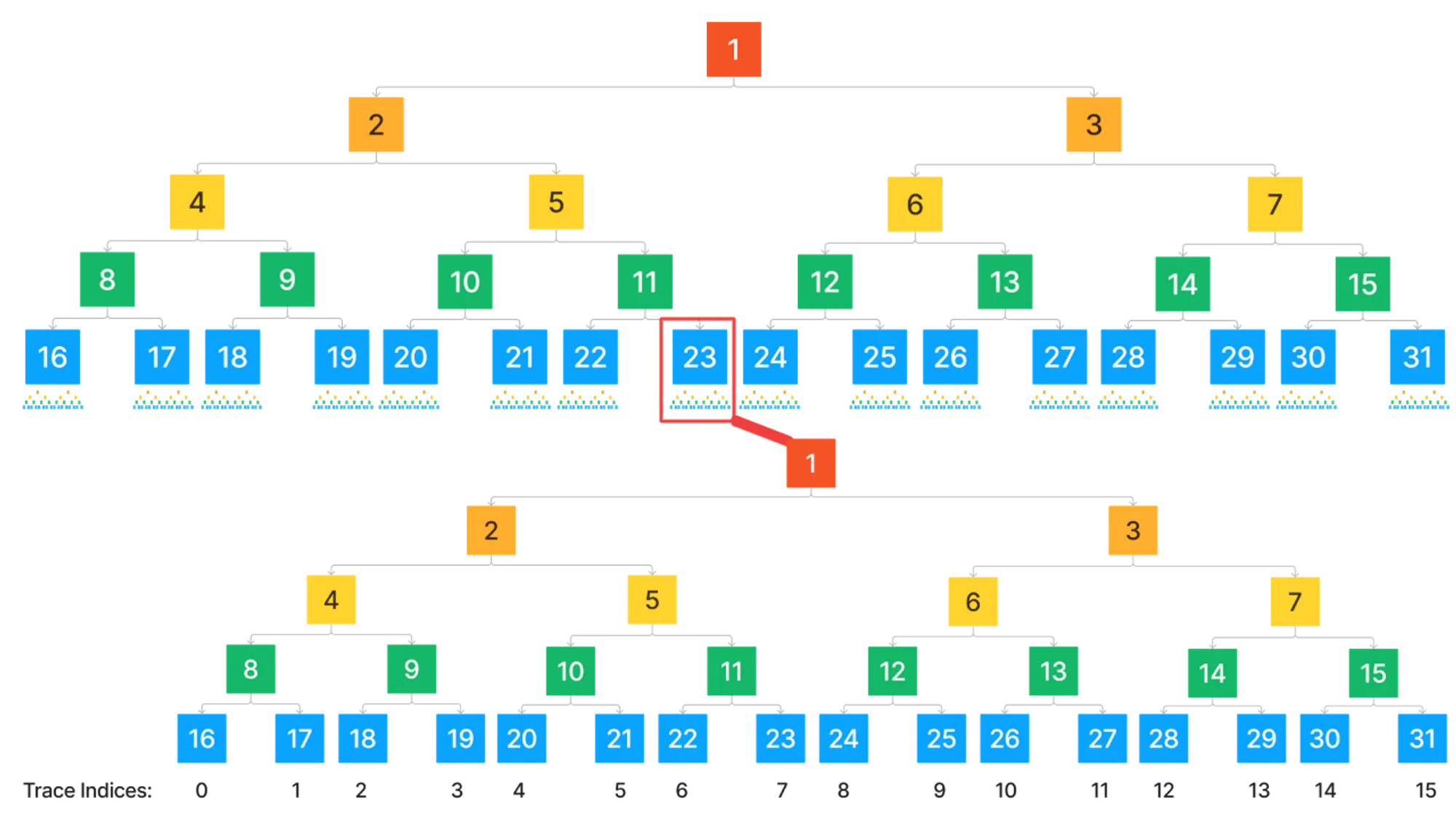
Position
A position represents the location of a claim in the Game Tree. This is represented by a “generalized index” (or gindex) where the high-order bit is the level in the tree and the remaining bits is a unique bit pattern, allowing a unique identifier for each node in the tree.
Thegindexof a position can be calculated as
- is a function returning the depth of the position in the Game Tree
- is a function returning the index of the position at its depth (starting from the left).
Actors
The game involves two types of participants (or Players): Challengers and Defenders.
Attack
A logical move made when a claim is disagreed with.
Defend
The logical move against a claim when you agree with both it and its parent.
Step
At MAX_GAME_DEPTH ,the FDG is able to query the VM to determine the validity of claims.
Resolution
Resolving the FDG determines which team won the game.In order for a claim to be considered countered, only one of its children must be uncountered.

Alphabet Game
challenger:ABCDEFGH
proposer:ABCDEXYZ

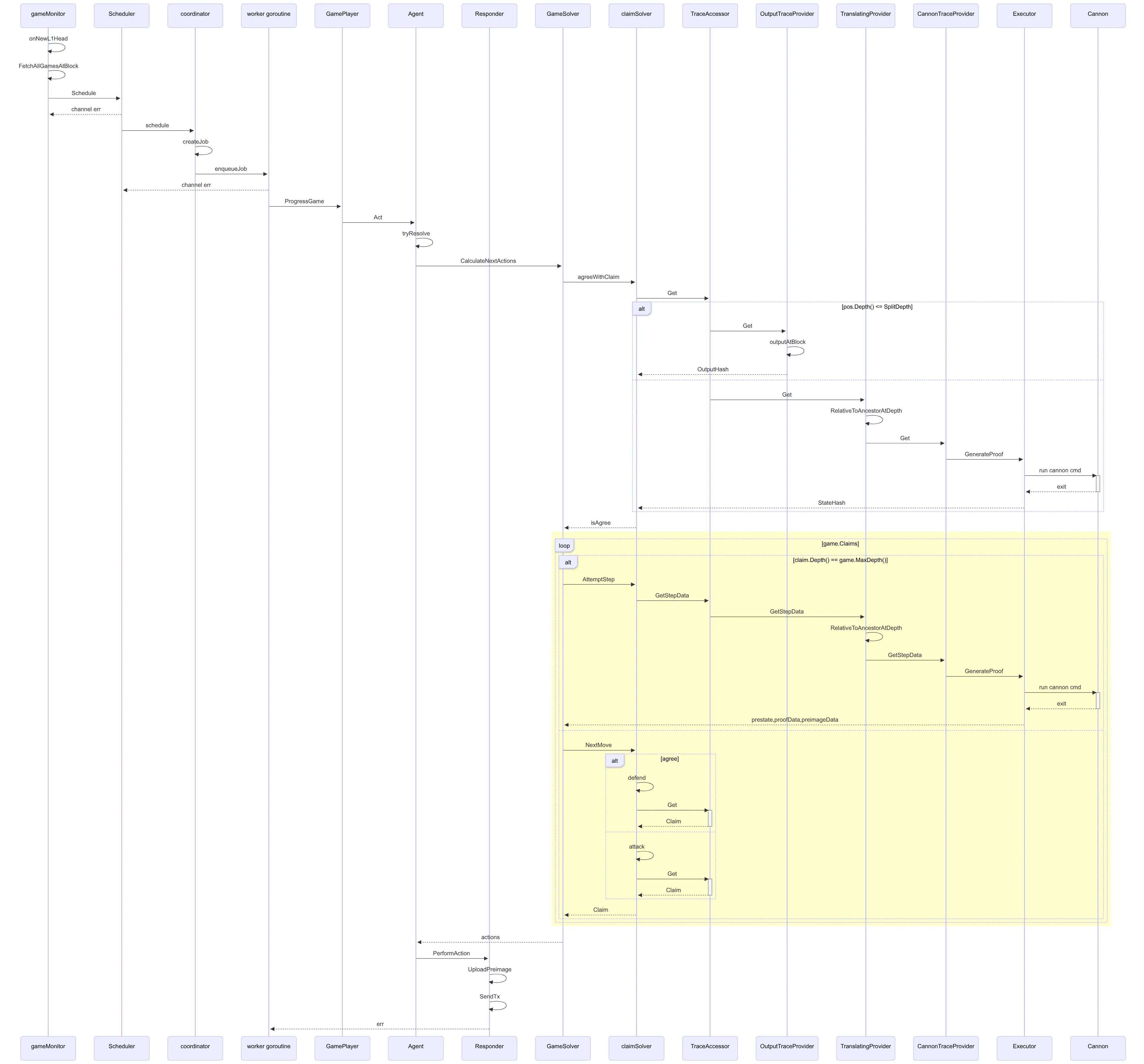
mermaid
sequenceDiagram participant gameMonitor participant Scheduler participant coordinator participant worker goroutine participant GamePlayer participant Agent participant Responder participant GameSolver participant claimSolver participant TraceAccessor participant OutputTraceProvider participant TranslatingProvider participant CannonTraceProvider participant Executor participant Cannon
gameMonitor->>gameMonitor: onNewL1Head gameMonitor->>gameMonitor: FetchAllGamesAtBlock
gameMonitor->>Scheduler: Schedule Scheduler-->>gameMonitor: channel err
Scheduler->>coordinator: schedule coordinator->>coordinator: createJob coordinator->>worker goroutine: enqueueJob worker goroutine-->>Scheduler: channel err
worker goroutine->>GamePlayer: ProgressGame GamePlayer->>Agent: Act Agent->>Agent: tryResolve Agent->>GameSolver: CalculateNextActions GameSolver->>claimSolver: agreeWithClaim claimSolver->>TraceAccessor: Get alt pos.Depth() <= SplitDepth TraceAccessor->>OutputTraceProvider: Get OutputTraceProvider->>OutputTraceProvider: outputAtBlock OutputTraceProvider-->>claimSolver: OutputHash else TraceAccessor->>TranslatingProvider: Get TranslatingProvider->>TranslatingProvider: RelativeToAncestorAtDepth TranslatingProvider->>CannonTraceProvider: Get CannonTraceProvider->>Executor: GenerateProof Executor->>Cannon: run cannon cmd activate Cannon Cannon-->>Executor: exit deactivate Cannon Executor-->>claimSolver: StateHash end claimSolver-->>GameSolver: isAgree rect rgb(255, 255, 204) loop game.Claims alt claim.Depth() == game.MaxDepth() GameSolver->>claimSolver: AttemptStep claimSolver->>TraceAccessor: GetStepData TraceAccessor->>TranslatingProvider: GetStepData TranslatingProvider->>TranslatingProvider: RelativeToAncestorAtDepth TranslatingProvider->>CannonTraceProvider: GetStepData CannonTraceProvider->>Executor: GenerateProof Executor->>Cannon: run cannon cmd activate Cannon Cannon-->>Executor: exit deactivate Cannon Executor-->>GameSolver: prestate,proofData,preimageData else GameSolver->>claimSolver: NextMove alt agree claimSolver->>claimSolver: defend claimSolver->>TraceAccessor: Get activate TraceAccessor TraceAccessor-->>claimSolver: Claim deactivate TraceAccessor else claimSolver->>claimSolver: attack claimSolver->>TraceAccessor: Get activate TraceAccessor TraceAccessor-->>claimSolver: Claim deactivate TraceAccessor end claimSolver-->>GameSolver: Claim end end end GameSolver-->>Agent: actions Agent->>Responder: PerformAction Responder->>Responder: UploadPreimage Responder->>Responder: SendTx Responder-->>worker goroutine: errZKP
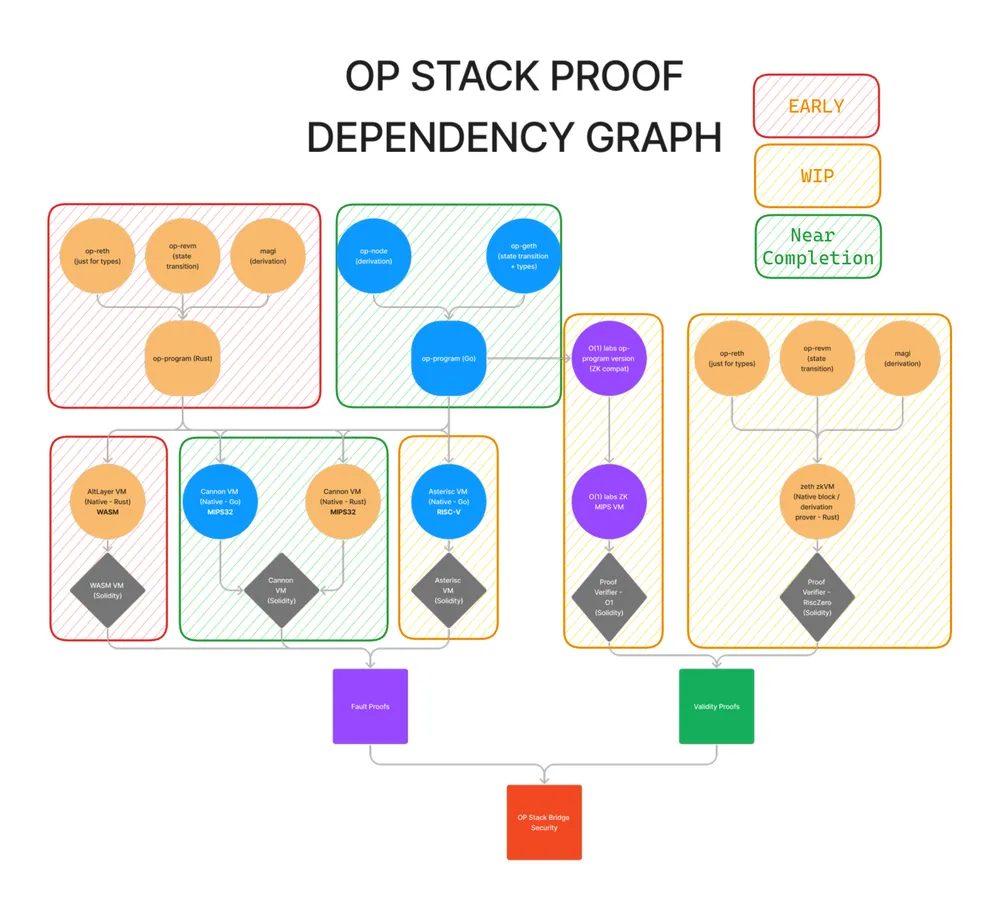
https://github.com/ethereum-optimism/ecosystem-contributions/issues/61
O(1) Labs
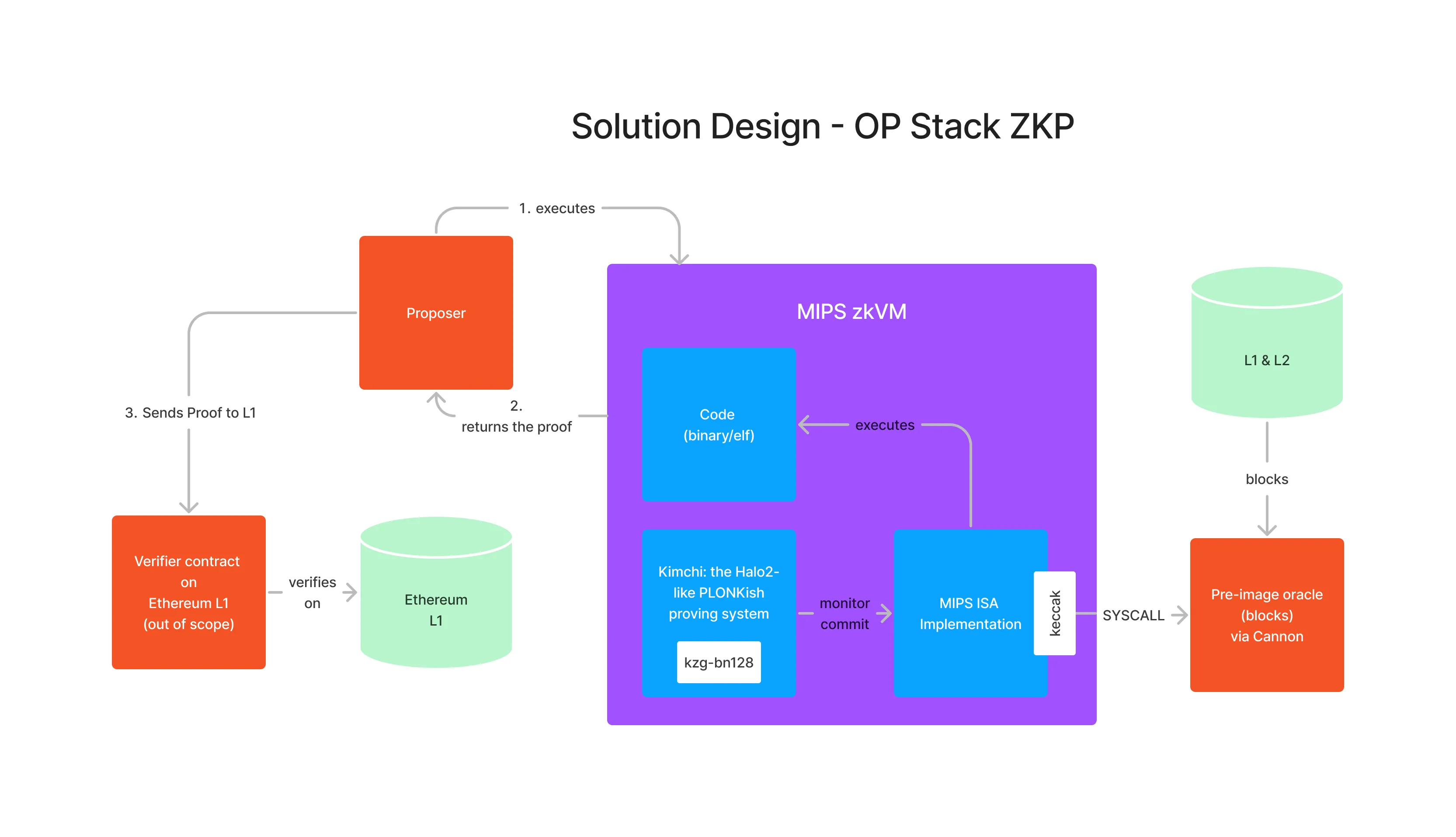
RISC Zero
- To modify our Ethereum ZK client to have first-class support for Optimism. This will make it possible to prove that a given Optimism block is valid, in the sense that it was obtained by starting from a given “parent” block, together with a sequence of transactions (see next bullet).
- To implement Optimism’s L1 -> L2 derivation logic within our zkVM. This will make it possible to prove that a given sequence of transactions was generated by the Optimism sequencer.
- To implement an epoch union. This will make it possible to prove that a sequence of Optimism epochs (each consisting of L2 blocks generated by our ZK client) is (1) sequentially consistent and (2) constructed using the L2 transactions obtained by the L1 -> L2 derivation logic.